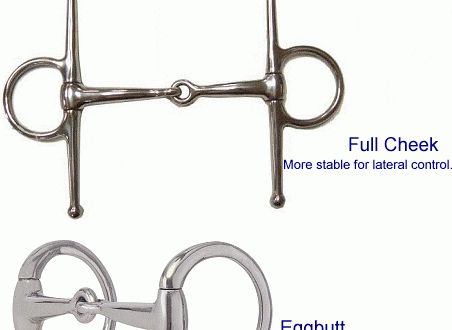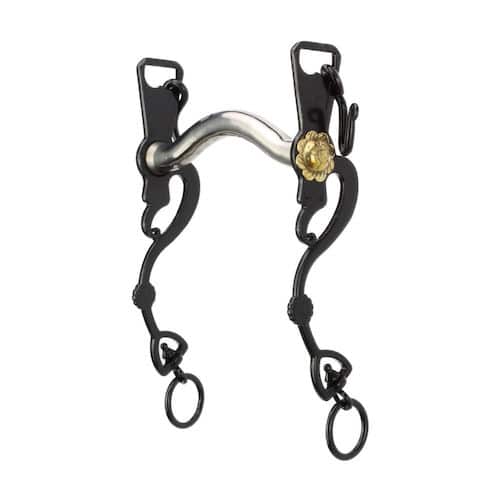
Types of iron: snaffles, mouthpieces, caps (review)
Texture, materials and types of snaffles
The texture of the gnaw may be soft, wavy, ribbed, embossed or rough.
Irregular bits, such as twist bits (thick snaffle twisted 3-4 turns), wired or twisted wire snaffle, are designed to “make a hard-chested horse easy to handle”, in other words, they easily hurt the horse, and therefore , in our opinion, should not be used.
Bits are usually made of stainless steel, cold rolled steel or copper alloys.
Stainless steel high quality has a shiny, smooth, durable surface that will not rust, in addition, it does not form pits. With regard to salivation, stainless steel is considered a neutral material.
Cold rolled steel pressed to form a uniformly dense material, softer and darker than stainless steel. This material is prone to rust, but many consider this a plus. The oxidation (rust) of the snaffle makes it taste sweet, which stimulates the horse to salivate. Therefore, such snaffles are also called “sweet iron”.
copper alloys, which have a golden red color, are used to create one-piece bits or as inserts in stainless steel or cold rolled steel snaffle bits. Copper increases salivation, but is too soft a metal that wears out quickly and can fray at the articulation or grind to sharp edges if the horse chews on the snaffle.
snaffle from aluminum and chromium alloy dry the horse’s mouth.
Rubber snaffle may seem completely harmless, but many horses find it unpleasant and try to spit it out. Horses that chew on a snaffle will quickly gnaw it. Fruit Flavored Snaffle are of the same type as rubber but have an apple or other fruit flavor. Some horses like them, others don’t care.
snaffle rings usually made flat or round. Round wire rings require much smaller holes than flat rings. The large “spacious” holes in the flat ring snaffle are notorious for pinching the lips. Also, as the flat rings move, they wear holes down to sharp edges that can rip the skin off.
The snaffle rings put pressure on the horse’s muzzle from the sides. Large rings (8 cm or more in diameter) apply pressure to the sensitive parts of the muzzle where the bone passes under the skin. Rings that are too small (less than 3 cm) can slip into the horse’s mouth and slip through his teeth. Some snaffle rings are textured, usually for beauty, but the texture is felt by the horse, so it’s best not to use them. The chances of erasing the skin on the face are too great. The snaffle “imperial” is made in such a way that it cannot pinch the skin. The connection is located above and below the corners of the mouth. The imperial is more stable than a simple round ring snaffle and therefore less mobile. Some horses need a looser snaffle, and some just need a more stable, fixed one. Snaffle with “whiskers” (“cheeks”) is either with full “whiskers” located above and below the bit, or with halves of the “whiskers” located above, and more often below the bit. “Moustache” on allows the snaffle to slip into the horse’s mouth. There are too many types of snaffles to list them all here, so I’ve compiled the most common ones here so you can take a look at them. You will also be able to see other types of hardware on the following pages.
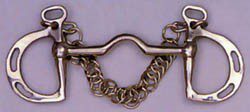 Pelam Kimberwick.
Pelam Kimberwick.
Strict snaffle. It has a smooth, one-piece bit with a low port. Made of stainless steel with 3 1/4″ rings. Used with a lip chain, has the effect of a lever snaffle.
Olympic Pelam with apple flavor.
It has a wavy straight mouth without a port. It tastes like an apple, but it’s still a fairly strict iron.
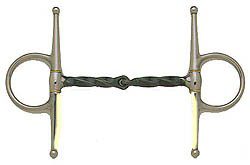 Full-Cheek snaffle with single joint.
Full-Cheek snaffle with single joint.
Made of stainless steel and slightly twisted. Very strict snaffle.
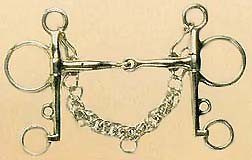 Pelham Winchester with one articulation.
Pelham Winchester with one articulation.
From stainless steel. Two occasions are usually attached to such iron. Has the effect of lever iron.
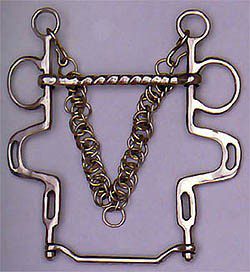 Buxton Bit, used for driving.
Buxton Bit, used for driving.
The long levers, the chain and the effect of the pelama already make it harsh, but in addition to this, there is no freedom for the tongue, and the bite is twisted.
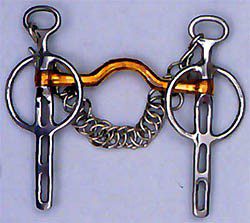 Dear Liverpool, used for driving.
Dear Liverpool, used for driving.
It has a very low port, the bit is made of copper. This snaffle also has the effect of a lever iron and provides for various ways of attaching the rein (to different pairs of rings).
 Cherry Roll Snaffle
Cherry Roll Snaffle
With one joint, rollers and round rings.

Stainless steel snaffle with D-rings, alternating copper and stainless steel rollers.

A simple one-joint snaffle with a rubber-coated bit. The rings have whiskers pointing down. This is a soft snaffle.
 Imperial with one articulation.
Imperial with one articulation.
A simple snaffle with twisted wire rings. Has flat rings to keep the movable, articulated bit from tipping over in the horse’s mouth if more downward pressure is applied to the tongue, pressing it harder. Strict snaffle.
 Trenzel Wilson, used for driving.
Trenzel Wilson, used for driving.
This is a single joint snaffle with additional rings to prevent the snaffle rings from slipping into the horse’s mouth.
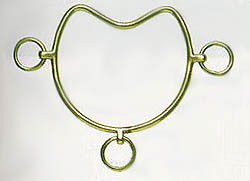 Chifney snaffle for stallions (“excretory iron”).
Chifney snaffle for stallions (“excretory iron”).
Used for guiding, not for riding. Very harsh.
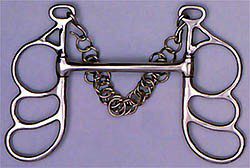 Snaffle Butterfly with whole mouth.
Snaffle Butterfly with whole mouth.
The snaffle is used in driving. There is no freedom for language, there is a leverage effect. Very harsh.
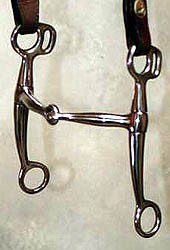 Pelyam Tom Thumb.
Pelyam Tom Thumb.
Many mistakenly call it a simple lever iron. In the section on combined iron, we will talk about such snaffles in more detail.
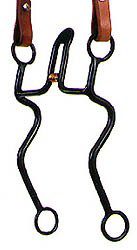 Winchester Cathedral mouthpiece.
Winchester Cathedral mouthpiece.
Blued steel with 9″ 5″ levers. XNUMX”- port on the bite. Extremely strict snaffle.
Mouthpiece with S-shaped cheeks and long levers, used for rouping. Port 1 height 2”, extended width, 1” diameter steel ring at the top for increased rigor, there is a mount for a jerk-line.
A simple snaffle bit is a snaffle without leverage that can have a solid or articulated bit. Because it has no leverage, a simple snaffle only works with direct pressure. The misconception that any articulating snaffle is simple has led some mouthpieces to be referred to as simple snaffles (such as the “Olympic snaffle”, the “cowboy snaffle” and the Tom Thumb snaffle). In reality, they all due to leverage are pelamas.
When you pull on one rein, the snaffle slides slightly in the horse’s mouth in the corresponding direction, and the ring on the opposite side presses on the corner of the mouth. In addition, pressure is exerted on the gum and tongue from the side from which the rein is pulled. The snaffle ring on the pick-up side moves away from the horse’s mouth, relieving pressure. No pressure is applied to the neck, nose, or jaw, so the action of the snaffle is more lateral (side to side) than vertical (up and down).
Simple snaffles are considered soft, but among them there are many severe ones.
Stringency is determined by the thickness, texture of the snaffle, and whether the snaffle is articulated or not. Some bits are twisted, and this is especially hard on the horse’s mouth.
Articulated snaffle leaves room for the tongue to move, but it can also squeeze the tongue like a nutcracker. This is most likely if the rider pulls hard on both reins and if the bit is too big for the horse’s mouth. If the horse’s palate is not high enough, the articulation can rest against it and cause pain. This, again, is most likely if the snaffle is large.
To avoid the effect of the nutcracker and not cause pain to the palate, some snaffles are made with three or more joints instead of two, and this is a good alternative if the horse’s palate is low.
Some snaffle are made from chainsand they are very strict. Sometimes chains with sharp edges are used – like bicycle chains! – there should be absolutely no place for this when training horses. On the one hand, snaffles made of chain and consisting of several joints cannot hit the horse in the palate, but on the other hand, their texture can cause pain. Remember that when you pull on one rein, the snaffle slips a little over the horse’s mouth, and if the snaffle is uneven, it can be very uncomfortable.
Snaffle bit with solid mouth may put too much pressure on the tongue, unless they have a slight curve to leave room for the tongue. A solid mouthpiece is stricter than a jointed mouthpiece of the same texture and thickness because it acts directly on the horse’s tongue.
Snaffle thickness very different – the thinner, the stricter. However, a very thick snaffle is also not always the best solution. Thicker bits are heavier and some horses don’t like it. If the horse is fine with this thickness but objects to the weight of the snaffle, a hollow snaffle of the same thickness can be purchased as it will be lighter. If the horse has a small mouth or thick tongue, it is best not to use a very thick snaffle as the horse may not be comfortable holding it in his mouth. Medium thickness is usually optimal for most horses.
This is usually the problem with rubber coated snaffles. The rubber makes the snaffle softer for the horse, but thicker at the same time. In addition, horses are usually worried about the taste of rubber and they try to spit out such snaffles.
snaffle rings also have an impact. The above described how a simple snaffle works: if you pull on the left rein, the snaffle will slide to the left side of the horse’s mouth, and the right ring will push down on the corner of the mouth. If the ring is too small, the snaffle can be pulled all the way through the horse’s mouth. It is important to use a snaffle with normal sized rings, however if they are too large they can chafe the animal’s snout.
The most common types of snaffle rings are round rings, D-shaped rings, and “imperial” – a heavily rounded letter D. The last two types are made so that they cannot pinch the corners of the horse’s lips. For the same purpose, snaffle bits with mustaches and mustache halves are made. The “whiskered” snaffle should not be confused with the mouthpiece, because the rein is attached not to the mustache, but directly to the snaffle, and there is no leverage effect. Such a snaffle cannot be pulled through the horse’s mouth.

Conventional articulated simple snaffle of medium thickness. Made of stainless steel with medium sized round rings. This is the most common type of snaffle and most horses are quite comfortable with it.

Snaffle bit with solid bit made of hard rubber. There is no freedom for the language, so this iron is quite strict. Has round rings.

A double-jointed snaffle called a “French snaffle”. Has D rings.
Waterford snaffle with four joints in the form of balls made of copper.
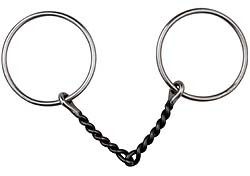
Very thin jointed, twisted simple snaffle with large round rings. Very strict.
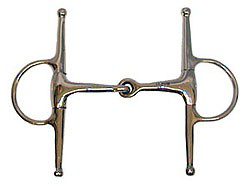
Articulated whisker snaffle, made of sweet iron, medium thickness. Soft snaffle that can be used on most horses.

Rubber coated articulated snaffle. The rings are round, but the rubber going over part of the ring makes the snaffle look like an imperial.
Double jointed stainless steel snaffle with round rings.
The mouthpiece has no articulations, and if it does, then it is no longer a mouthpiece, but a pelam. This bit provides vertical flexion (up and down), compared to a simple snaffle that turns the horse’s head sideways.
It helps set the horse’s head in the desired position and should be used in neck reining (opposite rein control on the neck) and not in direct reining.
For the mouthpiece to work as originally intended, it must be firmly fixed on the sides and must not move. This will give it the necessary stability and will avoid the problems that arise with pelyams, which will be discussed in more detail below. The mouthpiece is designed in such a way that if you pull on one rein, it will push on the opposite corner of the mouth, and it is its immobility that ensures this. When both reins are pulled, the levers move back, causing the lip chain (located under the horse’s chin) to tighten. Therefore, the lip chain is also responsible for the severity of the impact. The thinner it is, the more it will press. Some under the chin use a leather strap instead of an iron chain which is much more comfortable for the horse.
In addition, the mouthpiece moves upward, which creates pressure on the palate. This iron can also roll back in the horse’s mouth and put pressure on the tongue and gums. If the mouthpiece does not have a port (“bridge”, bend in the middle of the mouthpiece) or it is very small, then this will create a lot of pressure on the tongue, and such a mouthpiece will be strict. However, too high a port is also bad. On some mouthpieces, the port is so large that it reaches up to the palate and presses on it and on the gums.
Some mouthpieces pinch the tongue, others have rollers to prevent this. Rollers are basically designed to make the iron more comfortable for the horse, but even they have become a tool of severity: some rollers are made sharp to act on the horse even more. Mouthpieces vary greatly in severity, this is determined by all of the above factors, as well as the thickness of the mouthpiece and the length of the levers. The levers work like a crowbar – the longer they are, the greater the force of impact. If the levers are long, then dEven a very small effort can have a significant effect on the horse’s mouth. If the snaffle itself is loose and the rider has a soft hand and controls the neck reining, the mouthpiece can be quite comfortable for the horse. However, it is very important not to use this type of iron as a “tool of strength”.
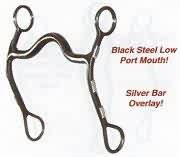
Western mouthpiece with long levers and medium height port. This is the softest mouthpiece in this article. Please note that there are no moving parts, all iron is solid.
A very strict mouthpiece with a high port, long levers and a very thin, stiff chain.
Another strict mouthpiece. There is no freedom for the tongue and there is a copper roller.
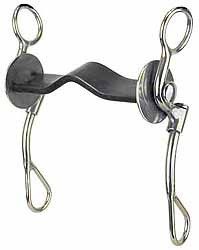
This is iron for rouping. The mouthpiece is flattened to cut into the horse’s tongue and gums. The most severe mouthpiece on this page.
A simple snaffle turns the horse’s head to the sides, the mouthpiece is responsible for vertical bending. Combination and sliding snaffles were invented in an attempt to combine these two effects.
In dressage, the problem was solved by putting both bits together in the horse’s mouth, which is also common in driving. This is, in fact, the only effective way to combine the necessary features of both types of iron. However, the use of two bits and two pairs of reins requires the rider to be well coordinated and the beginner will not be able to use this combination properly.
Many snaffles are made as “simple snaffles with long levers”, i.e. articulated lever snaffles like Tom Thumb. Such snaffles act immediately on both sides of the muzzle, if you pull on one rein. A simple snaffle would then work so that the ring on the same side as the rein being pulled would move away from the mouth, relieving pressure. The snaffle slides a little over the mouth, the pressure appears on the other side, and the horse gives way to it.
If you attach the levers to an articulated snaffle that rides freely on the rings and fasten the reins to the bottom of the levers, the effect of the pressure changes. The more freely the snaffle dangles, the more moving parts it has, the more blurred its effect will be. If you pull on one rein, the bottom of the lever will rise, but at the same time, the top of the lever will push down on your mouth from the same side. After that, the iron will slide through the horse’s mouth and begin to put pressure on the opposite side of the mouth, tongue and gums. Also, if a chain is used, it will stretch under the horse’s jaw, and some of the pressure will be on the back of the head. Thus, the horse will receive pressure on all parts of the head at once, and it will not be easy for him to figure out which way he needs to yield. Even worse is the case when such iron is combined with a mechanical hackamore, and pressure is also applied to the nose. Rare horse will be able to feel comfortable with such iron! The sliding snaffle is a variation on this snaffle plan. Here the rein is passed through the rings of the snaffle itself and attached to the cheek straps of the bridle or secured to the nape of the horse. Some even go so far as to pass a steel wire over the back of the head in order to force the horse to lower its head as a result of sharp pressure.
Complete set of iron for dressage. Both a snaffle and a mouthpiece are used here, but since they are not combined into a single snaffle, they act independently. However, the horse appears to have too much to keep in its mouth.
An Olympic snaffle used primarily in show jumping. Many riders do not use a chain with this snaffle. The occasion can be attached to different pairs of rings, varying the severity.

Snaffle designed for Icelandic horses.
A very extreme sliding snaffle with steel wire running along the back of the horse’s head.
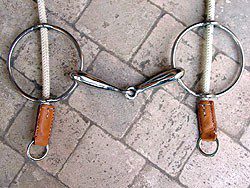
A sliding snaffle where the rein is attached to the bottom of the rings and a special strap passes through the rings and attaches to the headband’s cheek straps.
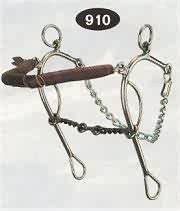
This iron is called “stop tap”. Here an attempt was made to combine all the sadism of various types of iron in a single design. The mouthpiece is thin, articulated and twisted, attached to long levers and to a mechanical hackamore. The hackamore itself is thin and stiff, as is the chain that runs under the jaw. A real instrument of torture!
Ellen Ofstad; translation by Anna Mazina (http://naturalhorsemanship.ru)
Original text and photos are located at www.ellenofstad.com




